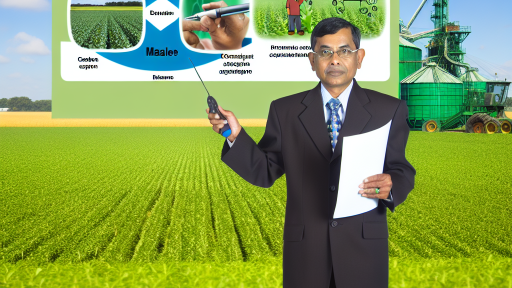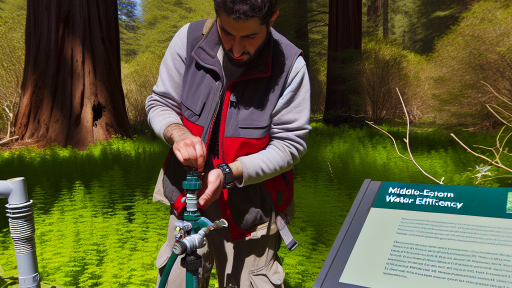Introduction to Agroforestry
Definitions of Agroforestry
Agroforestry integrates trees, crops, and livestock on the same land.
This practice enhances biodiversity and promotes sustainable land use.
It provides multiple outputs, such as food, timber, and ecological benefits.
Farmers utilize agroforestry systems to improve productivity and resilience.
Importance of Agroforestry in Sustainable Farming
Agroforestry plays a vital role in sustainable agriculture.
It helps to increase soil fertility using organic matter from trees.
This practice reduces erosion and improves water retention in soils.
Additionally, agroforestry enhances habitat for various species.
Economic Benefits
Agroforestry contributes to farmers’ income diversification.
It allows them to market a variety of products simultaneously.
This strategy can reduce financial risks associated with monoculture.
Moreover, it may qualify for government grants supporting sustainability.
Climate Change Mitigation
Agroforestry assists in mitigating climate change effects.
Trees sequester carbon, thus reducing greenhouse gases in the atmosphere.
This practice aids in adapting to fluctuating climate conditions.
Transform Your Agribusiness
Unlock your farm's potential with expert advice tailored to your needs. Get actionable steps that drive real results.
Get StartedAdditionally, agroforestry can enhance carbon storage in soils.
Principles of Agroforestry
Key Concepts
Agroforestry integrates trees with crops or livestock.
This practice enhances biodiversity on farms.
Moreover, it improves soil health and water conservation.
Farmers can benefit from multiple income sources.
Consequently, agroforestry increases resilience against climate change.
Practices in Agroforestry
Farmers often implement various practices in agroforestry.
For instance, alley cropping allows crops to grow between tree rows.
This method maximizes land use and minimizes soil erosion.
Another practice is silvopasture, combining trees, livestock, and forage.
This system improves animal welfare and promotes higher productivity.
Benefits of Agroforestry
Agroforestry promotes sustainable farming practices.
It has numerous ecological and economic benefits.
- Enhances habitat for wildlife.
- Improves carbon sequestration rates.
- Increases crop yields through ecological interactions.
Planning for Agroforestry
Effective planning is crucial for successful agroforestry systems.
Farmers should assess site conditions before implementation.
This includes evaluating soil type, microclimate, and topography.
Additionally, selecting appropriate tree species is essential.
Farmers can collaborate with local agricultural experts during planning.
Challenges and Considerations
Agroforestry does face certain challenges.
Initial setup costs can be high for some farmers.
There is also a need for knowledge about tree management.
However, education and workshops can mitigate these obstacles.
Ultimately, community support can enhance agroforestry practices.
Benefits of Agroforestry
Environmental Advantages
Agroforestry enhances biodiversity in farming landscapes.
Showcase Your Farming Business
Publish your professional farming services profile on our blog for a one-time fee of $200 and reach a dedicated audience of farmers and agribusiness owners.
Publish Your ProfileThis approach helps stabilize soils and prevent erosion.
Furthermore, it improves water retention and quality.
Additionally, agroforestry mitigates climate change effects.
It sequesters carbon, reducing greenhouse gas levels.
Moreover, it promotes the conservation of natural habitats.
Economic Advantages
Agroforestry diversifies farm income sources effectively.
This diversity reduces financial risks for farmers.
Additionally, it increases overall farm productivity.
Moreover, agroforestry enhances crop yields and quality.
This practice can also lower input costs significantly.
Farmers often benefit from access to new markets.
Social Benefits
Agroforestry fosters community resilience and cooperation.
This practice encourages knowledge sharing among farmers.
Furthermore, it supports traditional agricultural practices.
Additionally, it enhances food security in local communities.
Agroforestry creates green spaces that benefit mental health.
Finally, it improves the landscape’s aesthetic value.
Discover More: Conservation Tillage Practices For Small Farms
Site Assessment for Agroforestry
Soil Considerations
Soil quality is fundamental to successful agroforestry.
First, assess soil texture and composition.
Test for nutrient availability and pH levels.
Look for organic matter content to support plant health.
Consider conducting soil erosion tests as well.
Next, evaluate soil drainage and moisture retention.
These characteristics influence plant selection significantly.
Climate Factors
Understanding local climate is essential for agroforestry planning.
Identify temperature ranges throughout the year.
Examine local rainfall patterns and seasonal moisture levels.
Consider the growing season’s length for crop selection.
Be aware of potential climate-related risks like droughts or floods.
Topography Analysis
Topography plays a vital role in site assessment.
Analyze the slope and elevation of the land.
Higher slopes may require specific management techniques.
Consider the aspect, as it affects sunlight exposure.
Identify natural drainage patterns to prevent waterlogging.
Lastly, note any existing vegetation or ecosystems present.
Integration of Factors
Integrating these assessments aids in making informed decisions.
Soil, climate, and topography interact to impact agroforestry success.
This holistic view ensures better planning for diverse systems.
Ultimately, aim for a balanced approach to sustainable farming.
Showcase Your Farming Business
Publish your professional farming services profile on our blog for a one-time fee of $200 and reach a dedicated audience of farmers and agribusiness owners.
Publish Your ProfileDelve into the Subject: Top Recycling Practices for Sustainable Agriculture
Designing Agroforestry Systems: Techniques and Methodologies
Understanding Agroforestry Principles
Agroforestry integrates trees with crops and livestock.
This approach enhances biodiversity and soil health.
It also improves land productivity and reduces erosion.
Understanding these principles forms the foundation of effective planning.
Assessing Site Conditions
Site assessment is crucial for agroforestry planning.
Start by evaluating soil type and quality.
Next, analyze existing vegetation and wildlife.
This information informs appropriate tree and crop selection.
Consider climate factors, including temperature and rainfall patterns.
Such data helps project potential yields and returns.
Selecting Suitable Species
Choosing the right species is essential for success.
Native species often thrive better in local conditions.
Consider the growth habits of trees and crops.
This factor influences competition for resources.
Furthermore, select species that complement each other ecologically.
This enhances overall productivity and sustainability.
Designing the Layout
Designing an effective layout is key in agroforestry systems.
Create a plan that maximizes space and resource use.
Implement diverse arrangements, such as alley cropping and silvopasture.
These techniques optimize land productivity.
Utilize contour farming to control soil erosion.
This method enhances water retention and promotes healthy crops.
Implementing Management Practices
Effective management practices ensure long-term success.
Regular monitoring of plant health is necessary.
Utilize sustainable practices like organic farming.
This method reduces chemical dependency and enhances soil vitality.
Implement integrated pest management strategies.
These techniques help control pests while minimizing environmental impacts.
Evaluating System Performance
Continuous evaluation of agroforestry systems is vital.
Assess productivity and environmental impact periodically.
Look for changes in soil quality and biodiversity.
Adapt management practices based on these assessments.
Additionally, collect feedback from all stakeholders involved.
This collaboration enhances the system’s sustainability and effectiveness.
Discover More: Sustainable Greenhouse Designs For Year-Round Farming

Crop Selection in Agroforestry: Compatible Species and Diversity
Importance of Crop Selection
Choosing the right crops is vital for successful agroforestry.
It enhances ecological benefits and supports sustainable practices.
Moreover, compatible crops can improve overall farm productivity.
Identifying Compatible Species
Start by researching local climates and soil conditions.
Showcase Your Farming Business
Publish your professional farming services profile on our blog for a one-time fee of $200 and reach a dedicated audience of farmers and agribusiness owners.
Publish Your ProfileNext, consider native species that naturally thrive in your area.
Additionally, consult local agricultural extension services for recommendations.
Diversity and Its Benefits
Incorporating diverse species reduces the risk of crop failure.
It also promotes resilience against pests and diseases.
Furthermore, diverse crops enhance soil health through varied root systems.
Examples of Compatible Species
- Fruit trees like apples and pears pair well with shrubs.
- Leguminous crops such as clover enrich the soil.
- Root crops like carrots can grow alongside deeper-rooted trees.
Key Considerations for Crop Compatibility
Evaluate light, water, and nutrient requirements for each species.
Analyze growth habits to avoid competition for resources.
Finally, monitor crop interactions to adjust selections as needed.
Delve into the Subject: Enhancing Soil Health Through Sustainable Farm Planning
Implementation Strategies
Assessing Site Conditions
Begin by evaluating your site’s natural resources.
Identify soil types, water availability, and climate conditions.
Also, assess existing biodiversity and land usage.
This information guides your agroforestry design.
Setting Goals and Objectives
Clearly define your goals for the agroforestry system.
Consider whether you want to enhance biodiversity, reduce erosion, or increase profits.
These goals will shape your planning and design decisions.
Choosing Appropriate Agroforestry Practices
Select practices that align with your site assessment and goals.
Consider options like alley cropping, silvopasture, or forest farming.
Each practice has unique benefits for sustainability.
Designing the Layout
Create a detailed layout of your agroforestry system.
Incorporate windbreaks, shade areas, and crop rows.
Ensure proper spacing and orientation for optimal growth.
Implementing the Plan
Begin with soil preparation and planting trees or shrubs.
Follow with planting cover crops or companion plants.
Maintain clear records for tracking progress and outcomes.
Monitoring and Improving
Regularly monitor the health of your plants and soil.
Adjust management practices based on observed outcomes.
Utilize feedback to refine your agroforestry system over time.
Maintenance and Management: Ongoing Practices for Sustainability in Agroforestry
Regular Monitoring
Regular monitoring of agroforestry systems is crucial for success.
This practice involves assessing plant growth and health frequently.
Additionally, monitoring soil conditions helps in identifying issues early.
Farmers should document changes and take corrective actions as needed.
Soil Health Management
Healthy soil is the foundation of sustainable agroforestry.
Implementing cover cropping can enhance soil fertility and structure.
Regular soil testing guides appropriate nutrient management practices.
Organic amendments such as compost improve soil health over time.
Pest and Disease Control
Integrated pest management (IPM) is an effective strategy for pest control.
This approach combines biological, cultural, and mechanical practices.
Farmers should encourage beneficial insect populations to reduce pest impact.
Regular scouting helps in early identification of pests or diseases.
Showcase Your Farming Business
Publish your professional farming services profile on our blog for a one-time fee of $200 and reach a dedicated audience of farmers and agribusiness owners.
Publish Your ProfileTree Care and Maintenance
Proper care of trees promotes healthy growth and productivity.
Pruning is essential for maintaining tree shape and health.
Mulching around tree bases conserves moisture and suppresses weeds.
Protecting young trees from pests and environmental stress is vital.
Water Management
Efficient water management ensures sustainability in agroforestry.
Implementing rainwater harvesting systems can be beneficial.
Using drip irrigation optimizes water use and minimizes waste.
Regularly checking water sources helps ensure availability during dry spells.
Community Involvement and Education
Engaging the community fosters a collaborative approach to agroforestry.
Sharing knowledge and skills enhances overall farm sustainability.
Workshops and training sessions empower farmers to apply best practices.
Collaboration with local organizations can improve resource access.
Adapting to Climate Change
Climate resilience is vital for sustainable agroforestry practices.
Farmers should diversify plant species to enhance ecosystem stability.
Implementing agroecological practices can mitigate climate impacts.
Regularly updating management strategies will reduce vulnerabilities.
Additional Resources
Sustainable Agriculture Research and Education – SARE
Handbook for Agroforestry Planning and Design – SARE North Central




